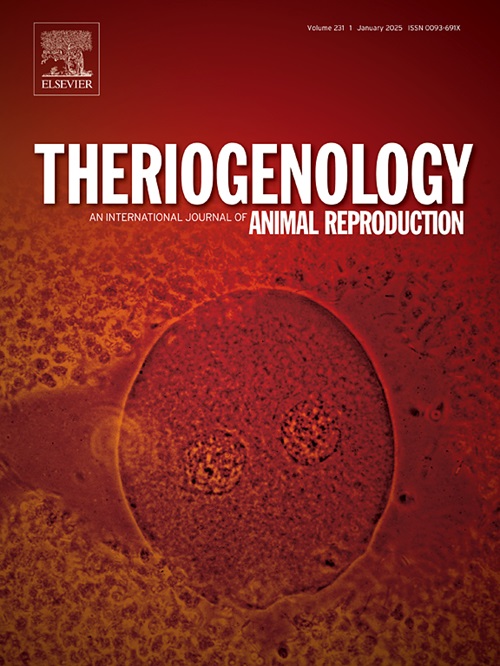Melatonin enhances the function of porcine immature Sertoli cells by inhibiting the HMGCS1-estradiol pathway
IF 2.4
2区 农林科学
Q3 REPRODUCTIVE BIOLOGY
引用次数: 0
Abstract
Melatonin (MT), a neurohormone synthesized and secreted primarily by the pineal gland, is of vital function to animal reproduction. However, the effects of gene expression and metabolism exerted by MT on porcine immature Sertoli cells (iSCs) remain unclear. Here, MT treatment (10 nM, 36h) elevated mitochondrial function and reduced oxidative stress, to promote proliferation and inhibit apoptosis of porcine iSCs. Transcriptome profiling identified 39 differentially expressed genes (DEGs) (33 known and 6 novel) (MT vs. Control), mainly involved in the steroid and glutamine metabolic processes, oxidoreductase activity and G protein coupled receptor binding (GO terms), and steroid biogenesis, pyruvate metabolism and AMPK signal pathways, etc (KEGG pathways). RT-qPCR validated 6 DEGs (Phgdh, Scd, Hmgcs1, Cytb, Pck2 and Sqle), with similar expression pattern to RNA-seq. Metabolomics further showed that 14 metabolites were significantly altered. The HMGCS1 protein abundance and the estradiol level were confirmed to be significantly decreased by MT (10 nM, 36h) treatment, and direct inhibition of HMGCS1 could also significantly reduce the estradiol level. However, levels of cholesterol and lactate were unchanged. Collectively, through integrated transcriptomics and metabolomics analysis, MT is demonstrated to inhibit the HMGCS1-estradiol pathway, to enhance the function of porcine iSCs.
褪黑素通过抑制hmgcs1 -雌二醇通路增强猪未成熟支持细胞的功能
褪黑素(Melatonin, MT)是一种主要由松果体合成和分泌的神经激素,对动物生殖具有重要作用。然而,MT对猪未成熟支持细胞(iSCs)基因表达和代谢的影响尚不清楚。在这里,MT处理(10 nM, 36小时)提高了线粒体功能,降低了氧化应激,促进了猪iSCs的增殖和抑制了细胞凋亡。转录组分析鉴定出39个差异表达基因(DEGs)(33个已知基因,6个新基因)(MT与对照),主要涉及类固醇和谷氨酰胺代谢过程、氧化还原酶活性和G蛋白偶联受体结合(GO术语),以及类固醇生物发生、丙酮酸代谢和AMPK信号通路等(KEGG通路)。RT-qPCR验证了6个DEGs (Phgdh、Scd、Hmgcs1、Cytb、Pck2和Sqle),表达模式与RNA-seq相似。代谢组学进一步表明,14种代谢物发生了显著改变。经MT (10 nM, 36h)处理后,HMGCS1蛋白丰度和雌二醇水平均显著降低,直接抑制HMGCS1也可显著降低雌二醇水平。然而,胆固醇和乳酸水平没有变化。总的来说,通过整合转录组学和代谢组学分析,证明MT可以抑制hmgcs1 -雌二醇通路,从而增强猪iSCs的功能。
本文章由计算机程序翻译,如有差异,请以英文原文为准。
求助全文
约1分钟内获得全文
求助全文
来源期刊

Theriogenology
农林科学-生殖生物学
CiteScore
5.50
自引率
14.30%
发文量
387
审稿时长
72 days
期刊介绍:
Theriogenology provides an international forum for researchers, clinicians, and industry professionals in animal reproductive biology. This acclaimed journal publishes articles on a wide range of topics in reproductive and developmental biology, of domestic mammal, avian, and aquatic species as well as wild species which are the object of veterinary care in research or conservation programs.
 求助内容:
求助内容: 应助结果提醒方式:
应助结果提醒方式:


